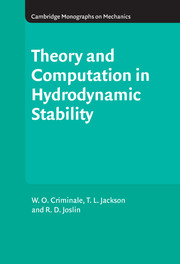Book contents
- Frontmatter
- Contents
- Figures
- Tables
- Preface
- 1 Introduction and problem formulation
- 2 Temporal stability of inviscid incompressible flows
- 3 Temporal stability of viscous incompressible flows
- 4 Spatial stability of incompressible flows
- 5 Stability of compressible flows
- 6 Centrifugal stability
- 7 Geophysical flow
- 8 Transient dynamics
- 9 Nonlinear stability
- 10 Transition and receptivity
- 11 Direct numerical simulation
- 12 Flow control and optimization
- 13 Investigating hydrodynamic instabilities with experiments
- References
- Author index
- General index
6 - Centrifugal stability
Published online by Cambridge University Press: 06 July 2010
- Frontmatter
- Contents
- Figures
- Tables
- Preface
- 1 Introduction and problem formulation
- 2 Temporal stability of inviscid incompressible flows
- 3 Temporal stability of viscous incompressible flows
- 4 Spatial stability of incompressible flows
- 5 Stability of compressible flows
- 6 Centrifugal stability
- 7 Geophysical flow
- 8 Transient dynamics
- 9 Nonlinear stability
- 10 Transition and receptivity
- 11 Direct numerical simulation
- 12 Flow control and optimization
- 13 Investigating hydrodynamic instabilities with experiments
- References
- Author index
- General index
Summary
Polar coordinates
As has been mentioned earlier, there are many flows that require the formulation of the stability problem to be cast in coordinate systems other than Cartesian. For example, pipe flow is perhaps the most notable example. Then, there is the case that is now referred to as stability of Couette flow and has been examined both theoretically and experimentally by Taylor (1921, 1923). In this case, concentric cylinders rotate relative to each other to produce the flow. Free flows, such as the jet and wake, can be thought of as round rather than plane. If the boundary layer occurs on a curved wall, then Görtler vortices result. All of these examples can be described in terms of polar coordinates. And, at the outset, it should be recognized that, not only will the governing mathematics be different from that that has been used up to this point but the resulting physics may have novel characteristics as well.
The prevailing basis for the flows that have been examined heretofore has been that the flows are parallel or almost parallel. Then, the solutions for the disturbances were all of the form of plane waves that propagate in the direction of the mean flow or, more generally, obliquely to the mean flow. And, as we have learned, if solid boundaries are present in the flow, viscosity is a cause for instability. Now there are flows that will have curved streamlines and this leads to the possibility of a centrifugal force and its influence must be considered.
- Type
- Chapter
- Information
- Theory and Computation of Hydrodynamic Stability , pp. 173 - 195Publisher: Cambridge University PressPrint publication year: 2003

